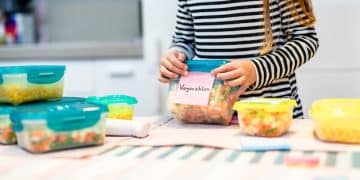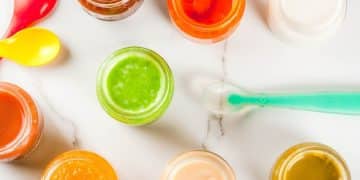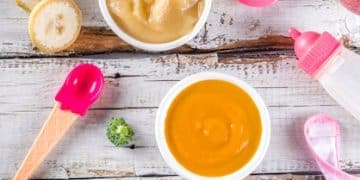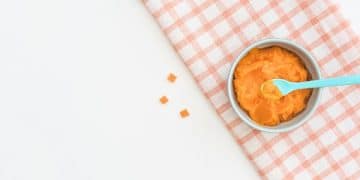Homemade Baby Food: 3 Recipes to Save 20% vs. Store-Bought
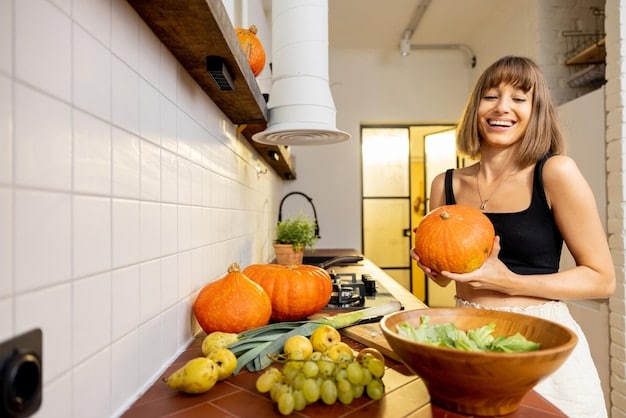
Homemade baby food offers a nutritious and cost-effective alternative to store-bought options; discover three simple recipes that can save you approximately 20% while providing your baby with fresh, wholesome meals.
Making homemade baby food: 3 recipes that save you 20% compared to store-bought, is a fantastic way to ensure your little one gets the best nutrition without breaking the bank. It’s simpler than you think, and the savings can really add up!
Why Choose Homemade Baby Food?
Opting for homemade baby food comes with a plethora of benefits that extend beyond just saving money. Let’s delve into why more and more parents are choosing to whip up their baby’s meals at home.
Nutritional Benefits
Homemade baby food allows you to control exactly what goes into your baby’s meals. No additives, preservatives, or excess sugars – just pure, wholesome goodness.
Cost Savings
As mentioned, making your own baby food can significantly cut down on expenses. Store-bought jars and pouches can be pricey, but fresh produce is often much more affordable.
Here are some additional reasons why homemade baby food trumps the store-bought alternatives:
- Transparency: You know exactly what your baby is eating.
- Customization: You can tailor recipes to suit your baby’s preferences and dietary needs.
- Freshness: Homemade food is often fresher and more flavorful than processed options.
Ultimately, choosing to make your baby’s food yourself empowers you to provide the best possible start in life, one nutritious spoonful at a time. It’s about being in control, knowing what’s best, and giving your baby the freshest possible start.
Getting Started: Essential Equipment and Ingredients
Before you embark on your homemade baby food journey, it’s helpful to gather the essential equipment and understand which ingredients are best suited for your little one. Let’s equip you with the knowledge you need!
Essential Equipment
You don’t need a lot of fancy gadgets to make baby food. Here are a few key items that will make the process easier:
- Steamer Basket: For softening fruits and vegetables while retaining nutrients.
- Blender or Food Processor: To achieve the perfect smooth puree.
- Ice Cube Trays or Small Containers: For portioning and freezing.
- Storage Containers: BPA-free containers to store the prepared baby food in the refrigerator or freezer.
Best First Foods
Certain fruits and vegetables are gentle on your baby’s digestive system and make great first foods:
- Avocado: Rich in healthy fats and easy to mash.
- Sweet Potato: Naturally sweet and packed with vitamins.
- Butternut Squash: Creamy texture and mild flavor.
- Apples: Gentle and easy to digest when cooked.

Remember to introduce new foods one at a time to watch for any allergic reactions. Keep it simple, and always consult with your pediatrician for guidance on introducing solids.
Recipe 1: Sweet Potato Puree
Sweet potato puree is a fantastic first food for babies. It’s naturally sweet, packed with nutrients, and easy to digest. Let’s explore how to create this simple, healthy dish!
Ingredients
You’ll only need one ingredient for this recipe:
- 1 medium sweet potato
Instructions
Follow these simple steps to create the perfect puree:
- Wash and peel the sweet potato, then cut it into small cubes.
- Steam the sweet potato cubes until they are tender, about 10-15 minutes.
- Transfer the cooked sweet potato to a blender or food processor.
- Blend until smooth, adding water or breast milk as needed to reach the desired consistency.
This recipe is a great way to introduce your baby to new flavors and textures, all while ensuring they get a dose of essential vitamins and minerals. It’s simple, quick, and loved by most babies!
Recipe 2: Apple Puree
Apple puree is another excellent choice for introducing solids to your baby. It’s mild, sweet, and easy on the tummy. Here’s how you can make a batch at home.
Ingredients
For this recipe, you’ll need:
- 2-3 apples (such as Gala or Fuji)
Instructions
Follow these steps for a smooth and delicious apple puree:
- Wash, peel, and core the apples, then chop them into small pieces.
- Steam the apple pieces until they are soft, about 8-10 minutes.
- Transfer the cooked apples to a blender or food processor.
- Blend until smooth, adding water as needed to reach a desired consistency.
Apple puree can be served warm or cold, and it’s a wonderful way to introduce your baby to the natural sweetness of fruits. Plus, it’s incredibly easy to make and customize to your baby’s liking.
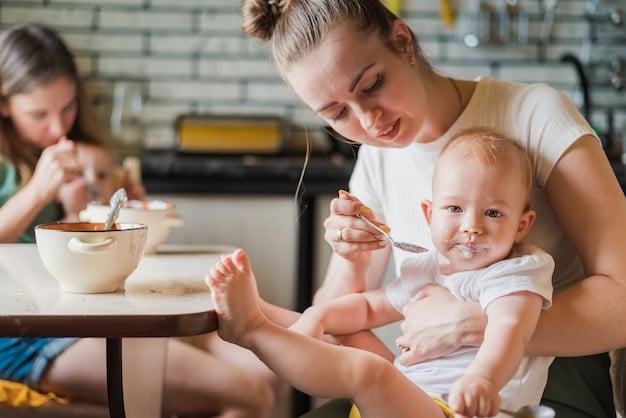
Recipe 3: Avocado Mash
Avocado mash is a no-cook baby food option that’s incredibly nutritious and easy to prepare. It’s packed with healthy fats and is perfect for babies just starting on solids.
Ingredients
The only ingredient you’ll need is:
- 1 ripe avocado
Instructions
Making avocado mash is as simple as it gets:
- Cut the avocado in half and remove the pit.
- Scoop out the flesh and place it in a bowl.
- Mash the avocado with a fork until it reaches a smooth consistency.
- Add breast milk or formula as needed to thin it out.
Avocado mash is a quick, convenient, and healthy way to feed your baby. Its creamy texture and mild flavor make it a hit with most little ones. Plus, it’s a great source of healthy fats that are essential for brain development.
Tips for Freezing and Storing Homemade Baby Food
Making baby food in batches and freezing it for later use is a huge time-saver. Just follow these tips to ensure that your homemade baby food stays fresh and safe for your little one.
Freezing Instructions
Here are some best practices for freezing baby food:
- Portion into Ice Cube Trays: Freeze the puree in ice cube trays for easy, single-serving portions.
- Transfer to Freezer Bags: Once frozen, transfer the cubes to freezer bags labeled with the date.
- Use Within Three Months: Frozen baby food is best used within three months for optimal quality and texture.
Thawing Instructions
When it’s time to thaw the baby food, follow these guidelines:
- Refrigerate Overnight: Thaw a portion in the refrigerator overnight.
- Microwave: Alternatively, thaw in the microwave, stirring frequently to ensure even heating.
- Discard Leftovers: Once thawed, use the portion within 24 hours and discard any leftovers.
Proper freezing and thawing techniques are crucial to maintaining the nutritional value and safety of your homemade baby food. Always follow these guidelines to ensure your baby gets the best and safest meals.
| Key Point | Brief Description |
|---|---|
| 💰 Save Money | Homemade baby food can save approximately 20% compared to store-bought options. |
| 🍎 Nutrition Control | You have complete control over ingredients, avoiding additives and preservatives. |
| 🥑 Simple Recipes | Recipes like sweet potato, apple, and avocado purees are easy to prepare. |
| 🧊 Freezing Tips | Freeze in ice cube trays and store in freezer bags for up to three months. |
Frequently Asked Questions
▼
Yes, homemade baby food is usually cheaper, as you are buying fresh produce in bulk which typically costs less than individual jars or pouches of store-bought baby food.
▼
Introduce new foods one at a time and watch for any allergic reactions like rashes, hives, vomiting, or diarrhea. If any reaction occurs, consult your pediatrician immediately.
▼
Yes, frozen fruits and vegetables are a convenient and nutritious option. Just make sure they are plain, without any added salt, sugar, or sauces.
▼
Homemade baby food can be stored in the refrigerator for up to 48 hours. Always use airtight containers to maintain freshness and prevent contamination.
▼
No, you don’t need special equipment. A blender or food processor, steamer basket, and ice cube trays are sufficient to get started with making homemade baby food.
Conclusion
Making homemade baby food: 3 recipes that save you 20% compared to store-bought, is a rewarding way to provide your baby with nutritious meals while saving money. With simple recipes and the right equipment, you can easily create fresh, customized food that your baby will love, giving them a healthy start in life.

